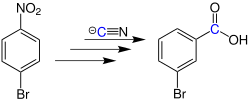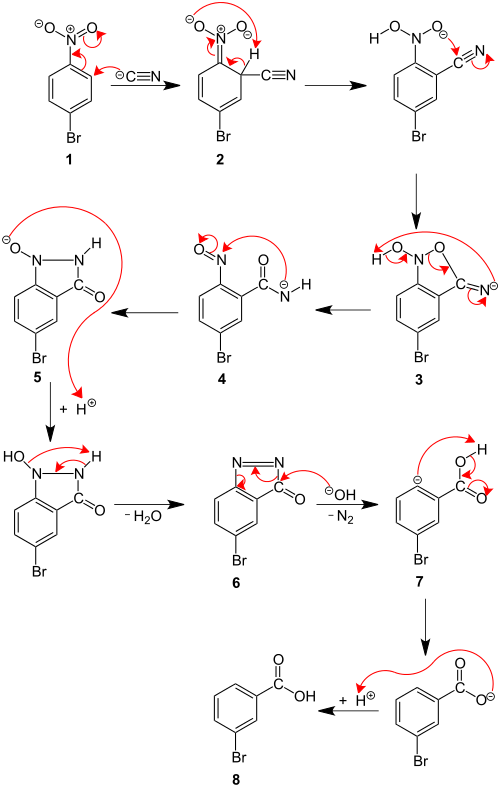Von Richter reaction
The Von-Richter reaction, also named Von-Richter rearrangement, is a name reaction in the organic chemistry. It is named after Victor von Richter, who discovered this reaction in year 1871. It is the chemical reaction of aromatic nitro compounds with potassium cyanide giving carboxylation ortho to the position of the former nitro group.[1][2][3]
General Reaction Scheme
The reaction below shows the conversion of bromonitrobenzene into bromobenzoic acid.

The reaction is an aromatic nucleophilic substitution.[4] Instead of bromine, chlorine could be a substituent. It gives only small yields of up to 20%.[5]
Reaction Mechanism
In the following mechanism bromine could be replaced by chlorine.[5]

First, the cyanide attacks the carbon-atom in ortho-position to the nitro-group 1. After this the compound is aromatic again 2. In the next step, the negative charged oxygen-atom attacks the neighbor carbon-atom and a five-membered ring is build 3. It opens under building a carconlylic-group 4. Next, an other five-membered ring is built 5. After a condensation, a double bond is build between the two nitrogen-atoms 6. Elemental nitrogen is cut of for opening the ring 7. In the last step, the compound is protonated and the 3-halogenbenzoic acid 8 is built.
Applications
This reaction has a limited application in organic synthesis.[5]
References
- ↑ V. von Richter (1871). "Untersuchungen über die Constitution der Benzolderivate (p )". Ber. dtsch. chem. Ges. 4 (1): 459–468. doi:10.1002/cber.187100401154.
- ↑ V. von Richter (1871). "Untersuchungen über die Constitution der Benzolderivate". Ber. dtsch. chem. Ges. 4 (2): 553–555. doi:10.1002/cber.18710040208.
- ↑ J. F. Bunnett (1958). "Mechanism and reactivity in aromatic nucleophilic substitution reactions". Quarterly Reviews Chemical Society. 12 (1): 1–16. doi:10.1039/QR9581200001.
- ↑ M. Smith, M.B. Smith, J. March: March's advanced organic chemistry: reactions, mechanisms, and structure, 6th edition, Wiley 2007, ISBN 978-0-471-72091-1.
- 1 2 3 Zerong Wang (2009) (in German), Comprehensive Organic Name Reactions and Reagents, New Jersey: John Wiley & Sons, pp. 2911-2914, ISBN 978-0-471-70450-8